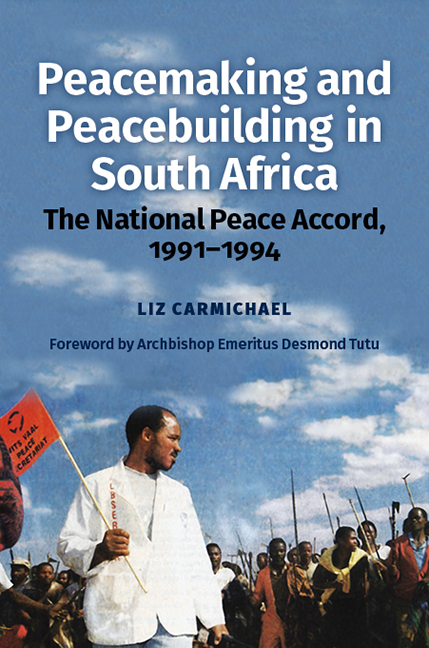Book contents
- Frontmatter
- Dedication
- Contents
- List of Illustrations
- List of Abbreviations
- Glossary
- Acknowledgements
- Note on Nomenclature
- Transition Timeline
- Foreword
- Introduction
- Part One Peacemaking, Peacebuilding, and the South African Conflict
- Part Two Peacemaking
- Part Three Peacebuilding
- Conclusion: Impact and Unfinished Business
- Bibliography
- Index
13 - Mobilizing the People, Making Peace Cool
Published online by Cambridge University Press: 08 October 2022
- Frontmatter
- Dedication
- Contents
- List of Illustrations
- List of Abbreviations
- Glossary
- Acknowledgements
- Note on Nomenclature
- Transition Timeline
- Foreword
- Introduction
- Part One Peacemaking, Peacebuilding, and the South African Conflict
- Part Two Peacemaking
- Part Three Peacebuilding
- Conclusion: Impact and Unfinished Business
- Bibliography
- Index
Summary
We see this as part of a total strategy to end the violence. We hope to eventually make it unfashionable.
What was so exciting was [that] it was a helluva change from selling baked beans and motor cars! And I guess it was a great privilege to be able to sell something like peace.
Introduction
Publicity was the one activity for which government had funds readily available. The NPC instantly established a Publicity and Communications Sub-committee and appointed leading advertising agencies, a PR agency, and Media Liaison Officer.
The advertising campaign began over Christmas, aiming to ‘sell’ peace itself, raise awareness of the Accord, encourage participation in the structures, and create a popular movement for peace. Each Christmas saw a fresh advertising launch. In between came launches of the Peace Song and Peace Doves symbol, the National Peace Campaign with its September 1993 Peace Day, and the declaration of 1994 as a Year of Peace. Slowly, media coverage changed from sceptical to enthusiastic as the structures grew and peace events balanced and in many places replaced reports of violence. The T-shirts were wildly popular. Peace became ‘cool’.
The Publicity Sub-committee moved to the NPS in August 1992; it was reconstituted as the Marketing Committee, and launched a research-based grassroots mobilization strategy with a major research workshop in March 1993. It established an Arts and Entertainment Sub-sub-committee. It adopted the Cape Town-based Media Peace Centre which aired peace programmes on radio and TV and pioneered mediation through ‘video dialogues’. Over Christmas 1993 the NPS Marketing Committee was replaced by the Marketing Division under Communications Coordinator Mark Manley. Manley ran workshops country-wide to encourage leaders to become active in peacebuilding, and oversaw the advertising to encourage a peaceful election. Closure aborted the Division's plans for continued grassroots peacebuilding, peace education, and the promotion of social cohesion.
How to ‘sell’ peace?
The Publicity and Communications Sub-committee was appointed at the NPC's first meeting on 1 October 1991. It convened on 22 October. Chaired by Hall, it initially consisted of two representatives from each main party: Saki Macozoma and Bernie Bernickson (ANC-Alliance), Suzanne Vos and Dr Denise Bjorkman (IFP/KZ government), Tertius Delport and Jac Rabie (NP/Government). Communications expert Lorraine Fourie was lent by the CDS.
- Type
- Chapter
- Information
- Peacemaking and Peacebuilding in South AfricaThe National Peace Accord, 1991-1994, pp. 252 - 289Publisher: Boydell & BrewerPrint publication year: 2022



